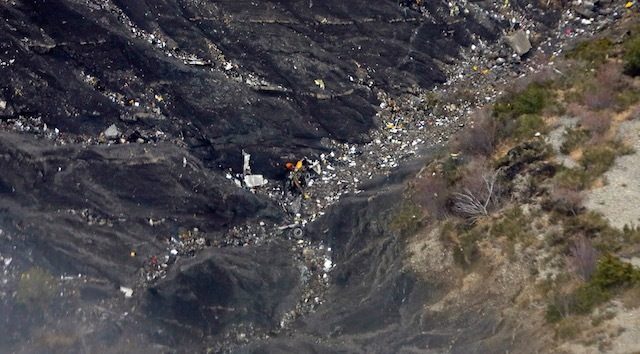SUMMARY
This is AI generated summarization, which may have errors. For context, always refer to the full article.

MARSEILLE, France – (UPDATED) Forensic teams have isolated 78 distinct DNA strands from body parts at the Germanwings crash site in the French Alps, while investigators continued their grim task in the arduous mountain terrain.
As well as trying to identify and return bodies to their families, search teams were also hunting for a second “black box” that has yet to be found 6 days into the search. (TIMELINE: The crash of Germanwings Flight 4U 9525)
The challenges of working on the steep and remote mountainside have been compounded by the violence of the impact – the plane is said to have crashed into the mountainside at a speed of 700 kilometers (430 miles) per hour, killing all 150 people on board.
“We haven’t found a single body intact,” said Patrick Touron, deputy director of the police’s criminal research institute.
He said the difficulty of the recovery mission was “unprecedented.”
“We have slopes of 40 to 60 degrees, falling rocks, and ground that tends to crumble,” said Touron. “Some things have to be done by abseiling.”
Search teams on the mountain were attached at all times to specialist mountain police.
So far, forensic teams have isolated 78 DNA strands from recovered body parts, said prosecutor Brice Robin, one of the lead investigators.
He said an access road was also being built to the site to allow all-terrain vehicles to remove some of the larger parts of the plane.
Helicopters have been going back and forth to the nearby town of Seynes – around 60 trips a day.
“Since safety is key, the recovery process is a bit slow, which is a great regret,” Touron said.
Most body parts were being winched up to helicopters before being transported to a lab in the nearby town of Seynes where a 50-strong team of forensic doctors and dentists and police identification specialists is working.
Between 400 and 600 body parts were currently being examined, Touron said.
The smallest details can prove crucial: fingerprints, jewellery, bits of ID card, teeth.
“In catastrophes, normally around 90% of identifications are done through dental records,” Touron added, but in the case of flight 9525, DNA was likely to play a greater role than normal.
Once DNA samples have been taken, they are sent to another lab outside Paris, where they are compared to samples taken from family members this week.
‘Essential for investigation’
The other top priority is finding the second “black box.”
“You have to be there to understand what we’re dealing with,” said one policeman, returned from the site.
“There is an engine turbine that was thrown 400 meters up from the point of impact.”
The debris of the plane is spread across some two hectares (5 acres) of mountainside.
The rescue teams, however, are not giving up.
“The teams are highly motivated,” said Stephane Laout, from one of the mountain brigades.
The second black box is also known as the “Flight Data Recorder,” which logs all technical data from the flight.
“It has been the priority from the start. It’s essential for the investigation,” said Captain Yves Naffrechoux, another mountain ranger.
“If it has not been completely destroyed or pulverized, the black box will be under the rubble and debris. We must work with caution and a lot of precision.”
The black box – which is actually orange in color and weighs around 10 kilos – was originally in a protective casing, but the empty casing has already been found.
“We have to look under every last bit of plane and lift every rock,” said Naffrechoux. – Rappler.com
Add a comment
How does this make you feel?
There are no comments yet. Add your comment to start the conversation.